Initial Study of the Effect of Some PVD Coatings (“TiN/AlTiN” and “TiAlN/a-C:N”) on the Wear Resistance of Wood Drilling Tools
Abstract
:1. Introduction
2. Materials and Methods
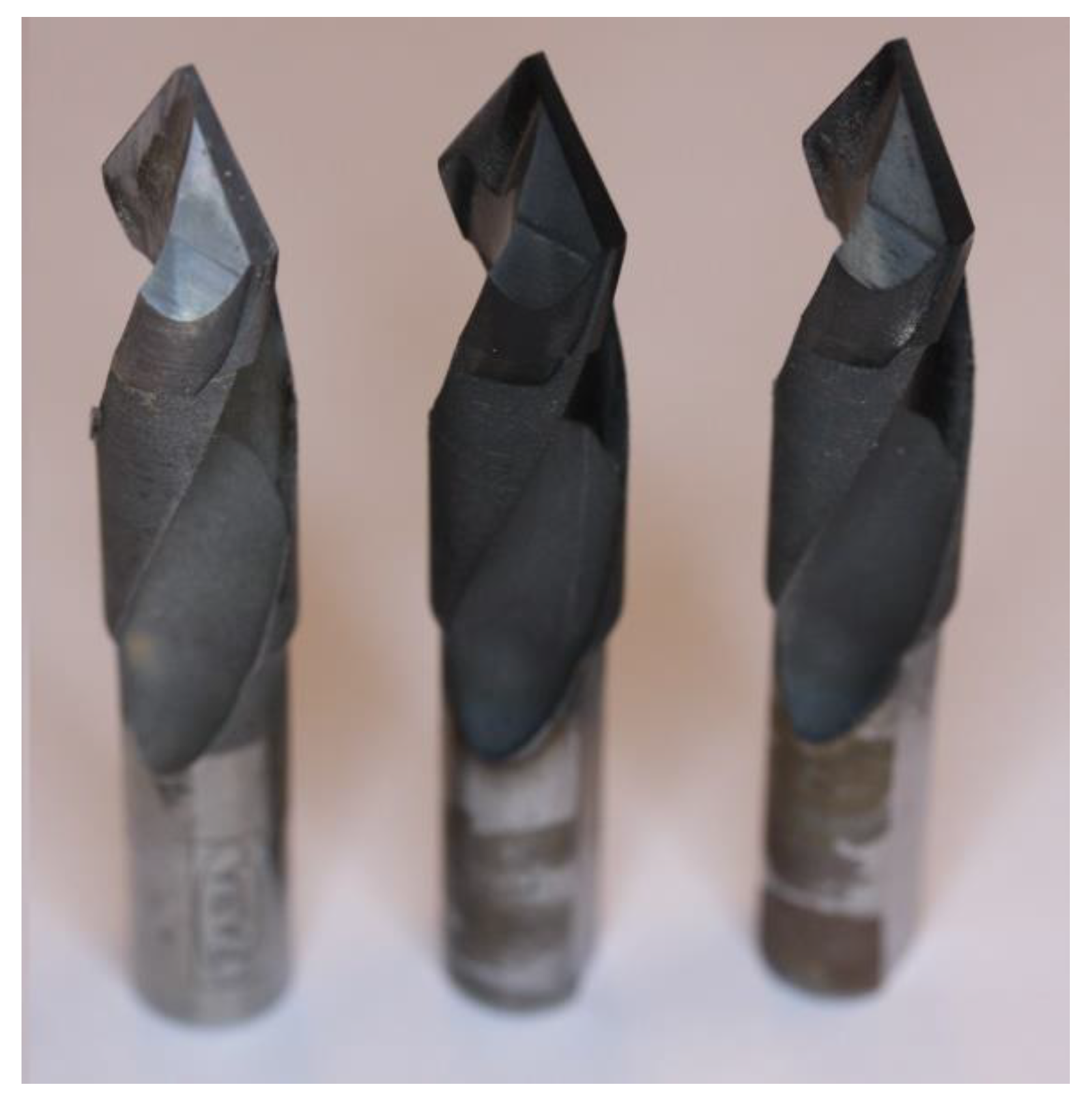
3. Results and Discussion
4. Conclusions
- The durability of standard (raw) tungsten cemented carbide K05 turned out to be more uniform (more reproducible) than the durability of the tested PVD coatings (“TiN/AlTiN” and “TiAlN/a-C:N”). This was a completely unexpected but clear drawback of using these coatings, especially “TiAlN/a-C:N”. The conclusion came from the analysis of the correlation between the wear of two blades used in the same two-blade drill. The fact that both these blades were cutting essentially the same material was very important because this circumstance reduces the effect of the unavoidable and random variation in the properties of the material that was drilled on the variation in tool wear. This correlation turned out to be the highest (with the coefficient of determination of R2 = 0.85) in Group A, which was the control group containing unmodified tools (the blades of these tools were made of raw tungsten cemented carbide K05). The lowest correlation (R2 = 0.59) was in Group C, which was the experimental group containing tools coated with “TiAlN/a-C:N”). For Group B (the experimental group containing tools coated with “TiN/AlTiN”), the coefficient of determination was rather moderate (R2 = 0.74) but smaller compared to the control group.
- The advantage (greater resistance to wear) of both tested coatings (“TiN/AlTiN” and “TiAlN/a-C:N”) over raw cemented carbide was statistically significant in the initial phase of machining (before 800 holes were drilled). This statistical significance was verified by standard analysis of variance (one-way ANOVA).
- Unfortunately, in the final phase of machining (when the number of holes drilled was over 800), only one coating (“TiN/AlTiN”) retained its advantage over raw cemented carbide. The effect of the second coatings (“TiAlN/a-C:N”) turned out to be statistically insignificant.
- In general, the results of the experimental study confirmed the conclusion made in previous research that the “TiN/AlTiN” coating seems to be much more effective than “TiAlN/a-C:N” in the case of woodworking tools.
Author Contributions
Funding
Institutional Review Board Statement
Informed Consent Statement
Data Availability Statement
Conflicts of Interest
References
- Śmietańska, K.; Górski, J.; Wilkowski, J. Long-term accuracy of MDF milling process-development of adaptive control system corresponding to progression of tool wear. Eur. J. Wood Wood Prod. 2013, 71, 383–385. [Google Scholar]
- Śmietańska, K.; Podziewski, P.; Bator, M.; Górski, J. Automated monitoring of delamination factor during up (conventional) and down (climb) milling of melamine-faced MDF using image processing methods. Eur. J. Wood Wood Prod. 2020, 78, 613–615. [Google Scholar] [CrossRef] [Green Version]
- Jegorowa, A.; Górski, J.; Kurek, J.; Kruk, M. Initial study on the use of support vector machine (SVM) in tool condition monitoring in chipboard drilling. Eur. J. Wood Wood Prod. 2019, 77, 957–959. [Google Scholar] [CrossRef] [Green Version]
- Górski, J.; Szymanowski, K.; Podziewski, P.; Śmietańska, K.; Czarniak, P.; Cyrankowski, M. Use of cutting force and vibro-acoustic signals in tool wear monitoring based on multiple regression technique for compreg milling. Bioresources 2019, 14, 3379–3388. [Google Scholar] [CrossRef]
- Jegorowa, A.; Górski, J.; Kurek, J.; Kruk, M. Use of nearest neighbors (k-NN) algorithm in tool condition identification in the case of drilling in melamine faced particleboard. Maderas-Cienc. y Tecnol. 2020, 22, 189–196. [Google Scholar] [CrossRef] [Green Version]
- Kurek, J.; Antoniuk, I.; Świderski, B.; Jegorowa, A.; Bukowski, M. Application of Siamese Networks to the Recognition of the Drill Wear State Based on Images of Drilled Holes. Sensors 2020, 20, 6978. [Google Scholar] [CrossRef]
- Szwajka, K.; Zielińska-Szwajka, J.; Trzepiecinski, T. Experimental Study on Drilling MDF with Tools Coated with TiAlN and ZrN. Materials 2019, 12, 386. [Google Scholar] [CrossRef] [Green Version]
- Kucharska, B.; Sobiecki, J.R.; Czarniak, P.; Szymanowski, K.; Cymerman, K.; Moszczyńska, D.; Panjan, P. Influence of Different Types of Cemented Carbide Blades and Coating Thickness on Structure and Properties of TiN/AlTiN and TiAlN/a-C:N Coatings Deposited by PVD Techniques for Machining of Wood-Based Materials. Materials 2021, 14, 2740. [Google Scholar] [CrossRef]
- Grobelny, T. Thermo-Mechanical Condition of the Tool Blade in the Process of Milling Wood and Wood Materials. Ph.D. Thesis, Warsaw University of Life Science, Warsaw, Poland, 1999. [Google Scholar]
- Darmawan, W.; Usuki, H.; Gottlöber, C.; Marchal, R. Wear characteristics of multilayer coated cutting tools in milling parti-cleboard. For. Prod. J. 2010, 60, 615–621. [Google Scholar] [CrossRef]
- Czarniak, P.; Szymanowski, K.; Kucharska, B.; Krawczynska, A.; Sobiecki, J.R.; Kubacki, J.; Panjan, P. Modification of tools for wood based materials machining with TiAlN/a-CN coating. Mater. Sci. Eng. B 2020, 257, 114540. [Google Scholar] [CrossRef]
- Kazlauskas, D.; Jankauskas, V.; Tuckute, S. Research on tribological characteristics of hard metal WC-Co tools with TiAlN and CrN PVD coatings for processing solid oak wood. Coatings 2020, 10, 632. [Google Scholar] [CrossRef]
- Czarniak, P.; Szymanowski, K.; Panjan, P. Characteristic of the wear of a tool coating based on amorphous carbon during chipboard milling. Ann. Wars. Univ. Life Sci. For. Wood Technol. 2020, 111, 53–59. [Google Scholar] [CrossRef]
- Nadolny, K.; Kapłonek, W.; Sutowska, M.; Sutowski, P.; Myśliński, P.; Gilewicz, A.; Warcholiński, B. Experimental tests of PVD AlCrN-coated planer knives on planing Scots pine (Pinus sylvestris L.) under industrial conditions. Eur. J. Wood Wood Prod. 2021, 79, 645–665. [Google Scholar] [CrossRef]
- Darmawan, W.; Usuki, H.; Quesada, J.; Marchal, R. Clearance wear and normal force of TiN-coated P30 in cutting hardboards and wood-chip cementboards. Holz Roh Werkst. 2008, 66, 89–97. [Google Scholar] [CrossRef]
- Fahrussiam, F.; Praja, I.A.; Darmawan, W.; Wahyudi, I.; Nandik, D.; Usuki, H.; Koseki, S. Wear characteristics of multilayer-coated cutting tools in milling wood and wood-based composites. Tribol. Ind. 2016, 38, 66–73. [Google Scholar]
- Beer, P.; Djouadi, M.A.; Marchal, R.; Sokolowska, A.; Lambertin, M.; Czyzniewski, A.; Precht, W. Antiabrasive coatings in a new application—Wood rotary peeling process. Vacuum 1999, 53, 363–366. [Google Scholar] [CrossRef]
- Alqallaf, J.; Ali, N.; Teixeira, J.A.; Addali, A. Solid Particle Erosion Behaviour and Protective Coatings for Gas Turbine Compressor Blades—A Review. Processes 2020, 8, 984. [Google Scholar] [CrossRef]
- Ali, N.; Teixeira, J.A.; Addali, A.; Al-Zubi, F.; Shaban, E.; Behbehani, I. The effect of aluminium nanocoating and water pH value on the wettability behavior of an aluminium surface. Appl. Surf. Sci. 2018, 443, 24–30. [Google Scholar] [CrossRef] [Green Version]
- Ali, N.; Teixeira, J.A.; Addali, A.; Saeed, M.; Al-Zubi, F.; Sedaghat, A.; Bahzad, H. Deposition of Stainless Steel Thin Films: An Electron Beam Physical Vapour Deposition Approach. Materials 2019, 12, 571. [Google Scholar] [CrossRef] [Green Version]
- Aamir, M.; Davis, A.; Keeble, W.; Koklu, U.; Giasin, K.; Vafadar, A.; Tolouei-Rad, M. The Effect of TiN-, TiCN-, TiAlN-, and TiSiN Coated Tools on the Surface Defects and Geometric Tolerances of Holes in Multi-Spindle Drilling of Al2024 Alloy. Metals 2021, 11, 1103. [Google Scholar] [CrossRef]
- Han, C.; Luo, M.; Zhang, D.; Wu, B. Mechanistic modelling of worn drill cutting forces with drill wear effect coefficients. Procedia CIRP 2019, 82, 2–7. [Google Scholar] [CrossRef]
- Liu, H.S.; Lee, B.Y.; Tarng, Y.S. In-process prediction of corner wear in drilling operations. J. Mater. Process. Technol. 2000, 101, 152–158. [Google Scholar] [CrossRef]
- EN 323; Wood-Based Panels: Determination of Density. CEN: Brussels, Belgium, 1999.
- EN 310; Wood-Based Panels: Determination of Modulus of Elasticity in Bending and of Bending Strength. CEN: Brussels, Belgium, 1993.
- EN 319; Particleboards and Fibreboards. Determination of Tensile Strength Perpendicular to the Plane of the Board. CEN: Brussels, Belgium, 1993.
- EN 320; Particleboards and Fibreboards. Determination of Resistance to Axial Withdrawal of Screws. CEN: Brussels, Belgium, 2011.
- EN 1534; Wood Flooring and Parquet: Determination of Resistance to Indentation—Test Method. CEN: Brussels, Belgium, 2002.
- ISO 3340; Fibre Building Boards—Fibre Building Boards—Determination of Sand Content: International Organization for Standardization. ISO: Geneva, Switzerland, 1976. Available online: https://cdn.standards.iteh.ai/samples/8621/5dae48ca9b4b408c9001b827ef9a1169/ISO-3340-1976.pdf (accessed on 20 May 2021).
- EN 317; Particleboards and Fibreboards: Determination of Swelling in Thickness after Immersion in Water. CEN: Brussels, Belgium, 1993.
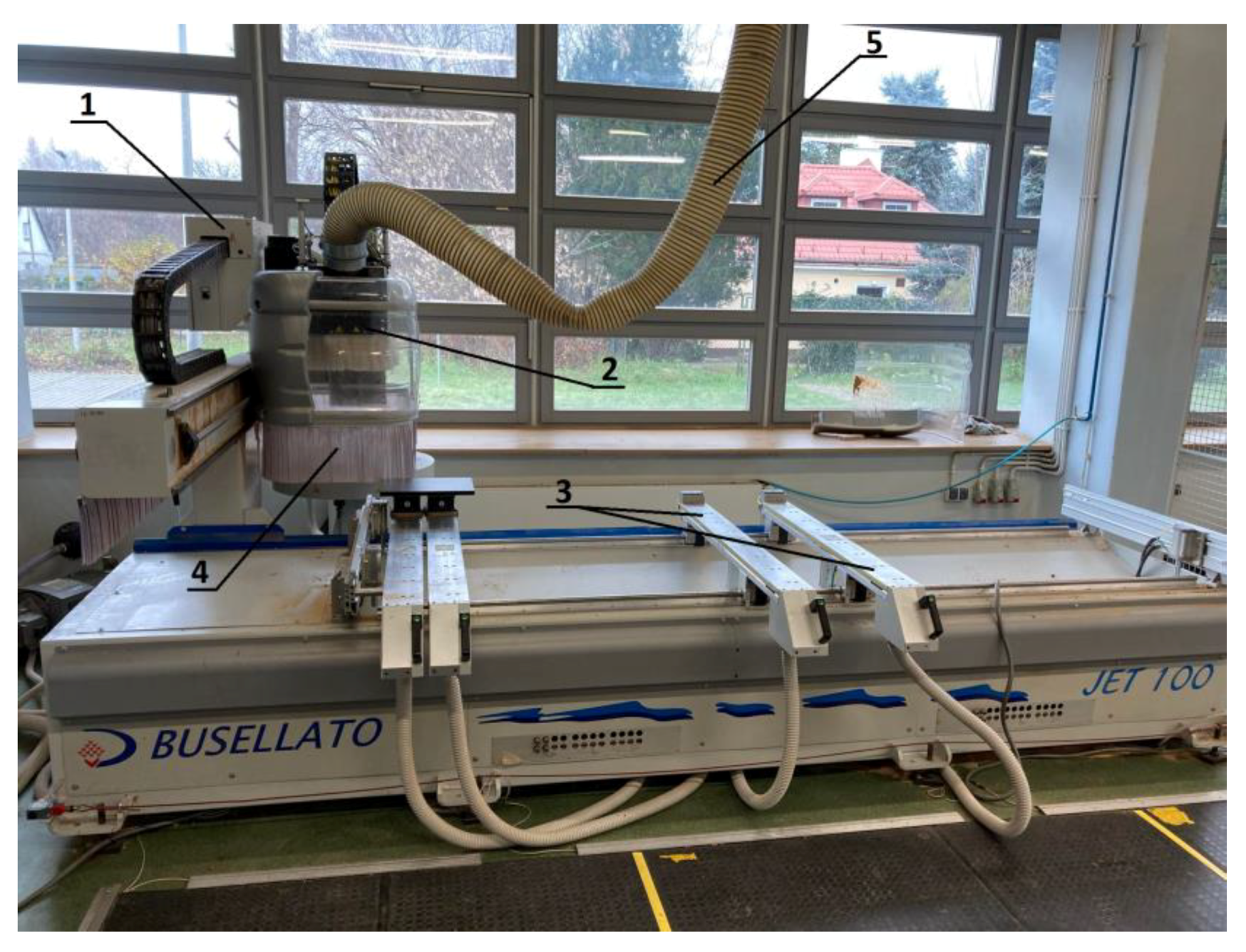

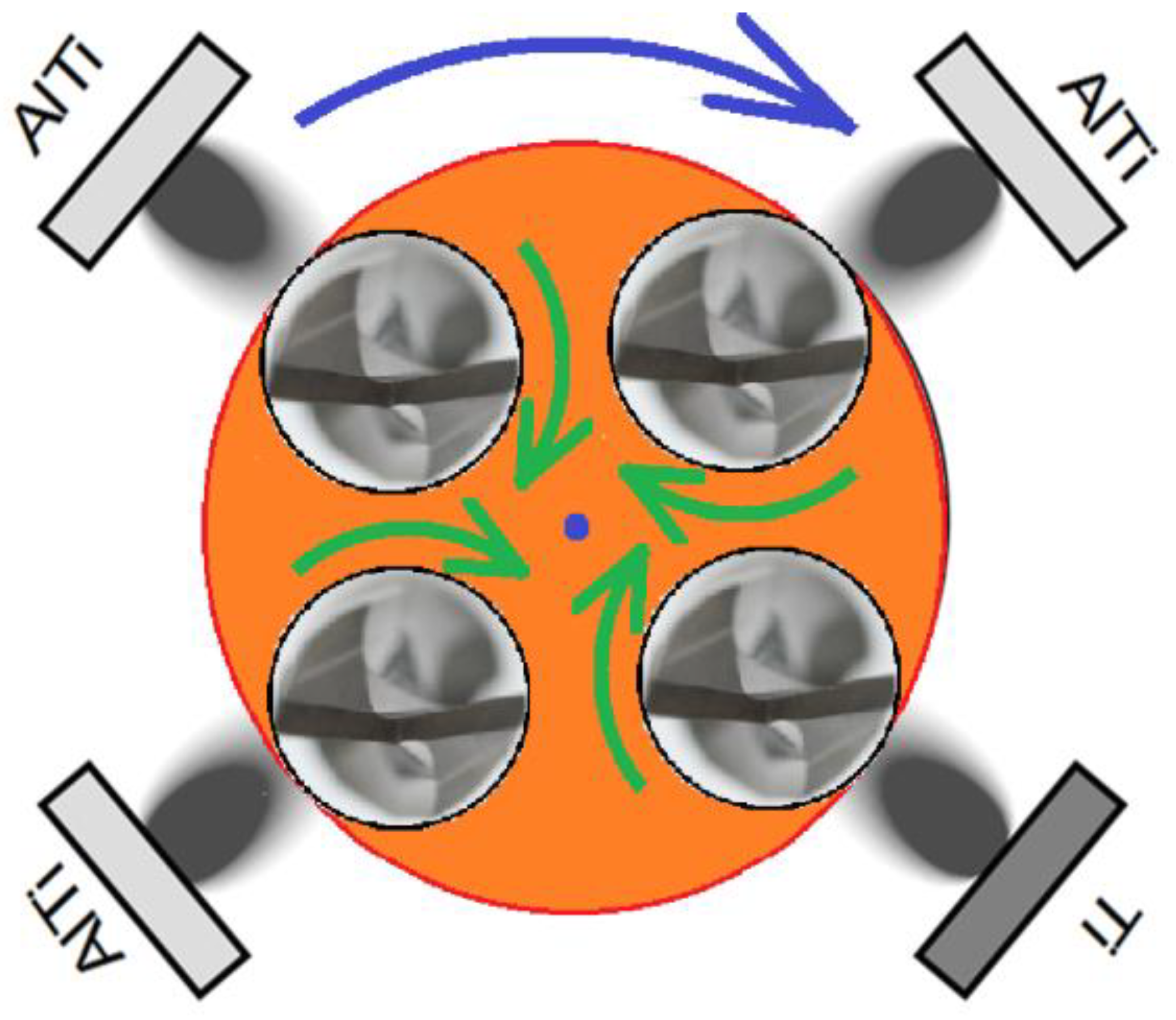

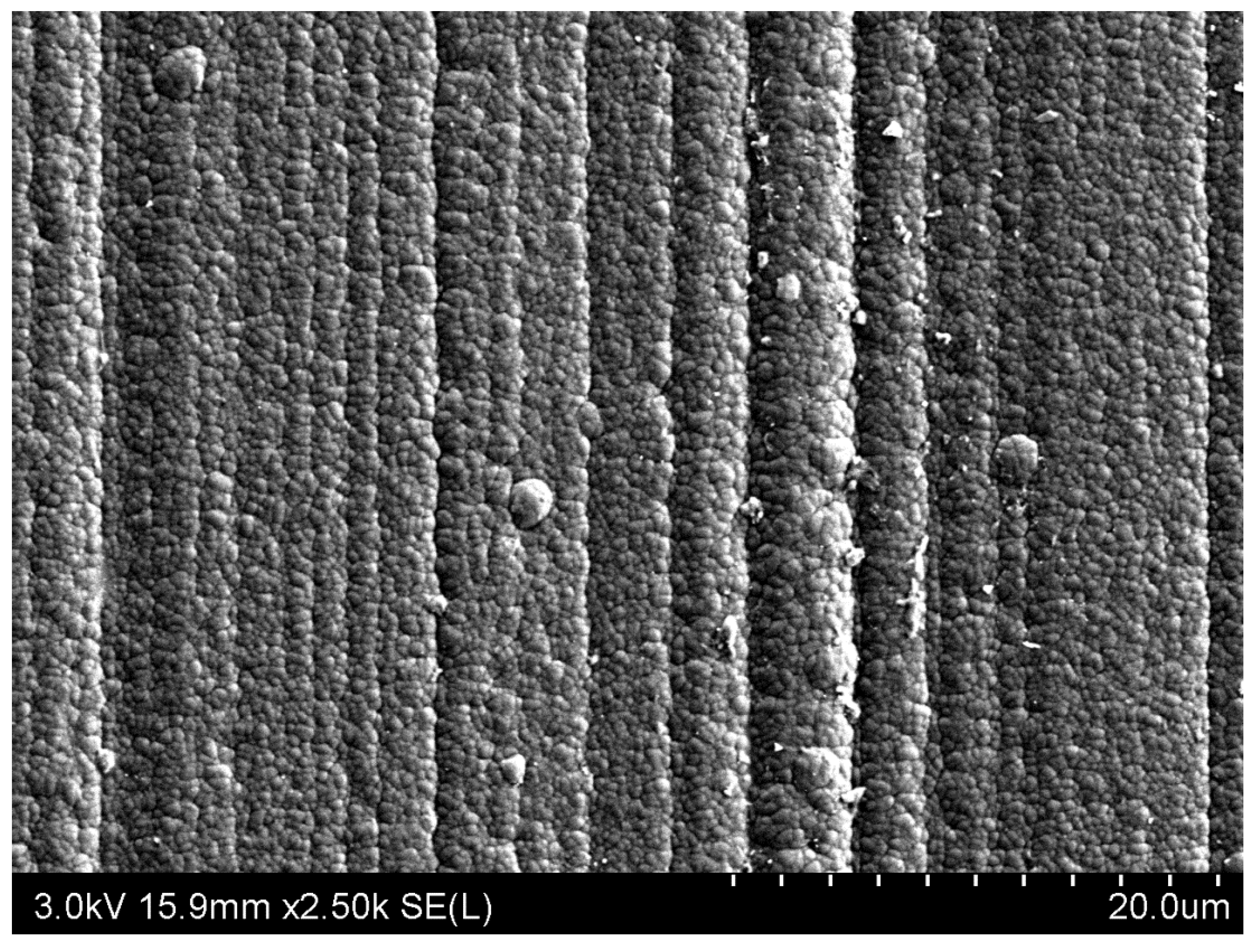
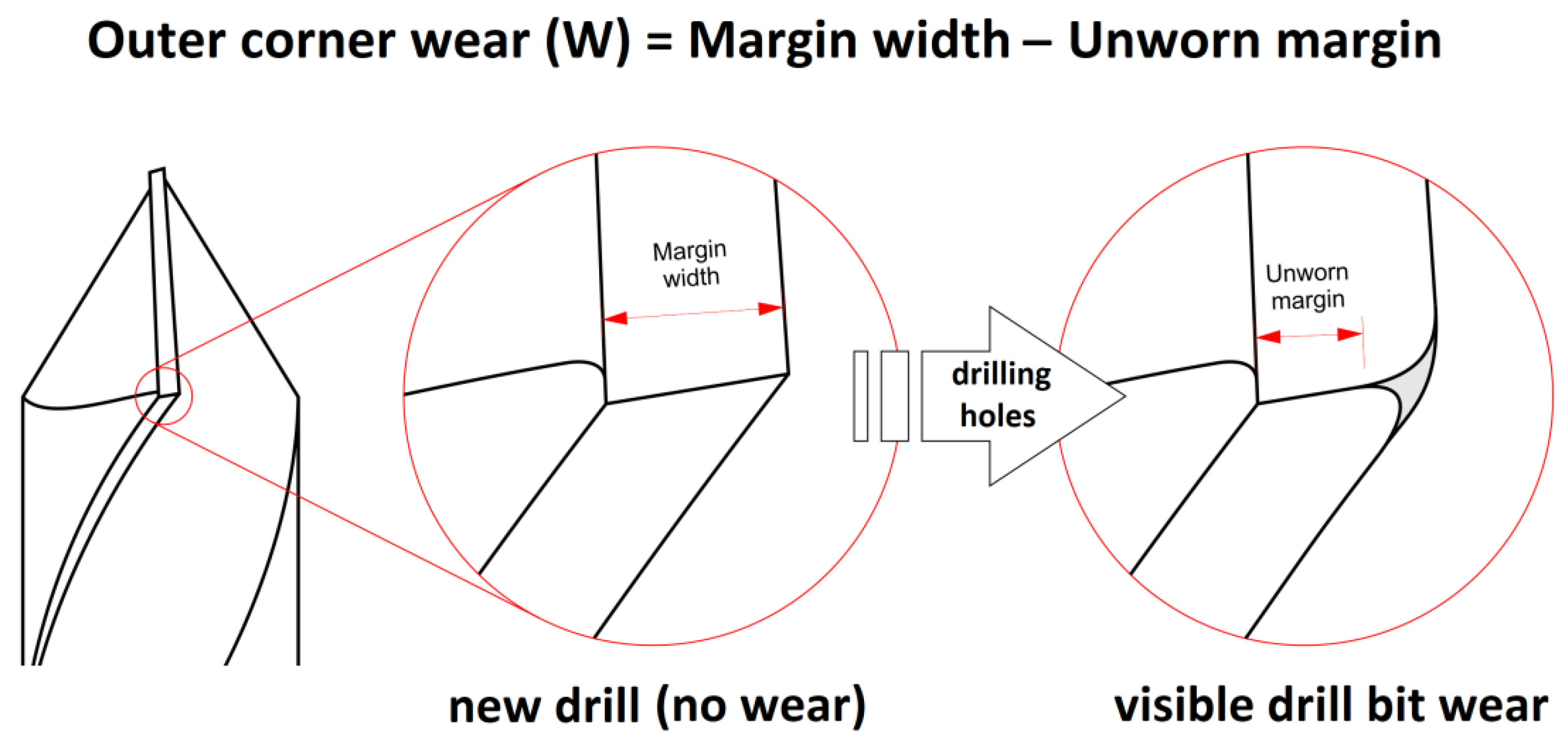


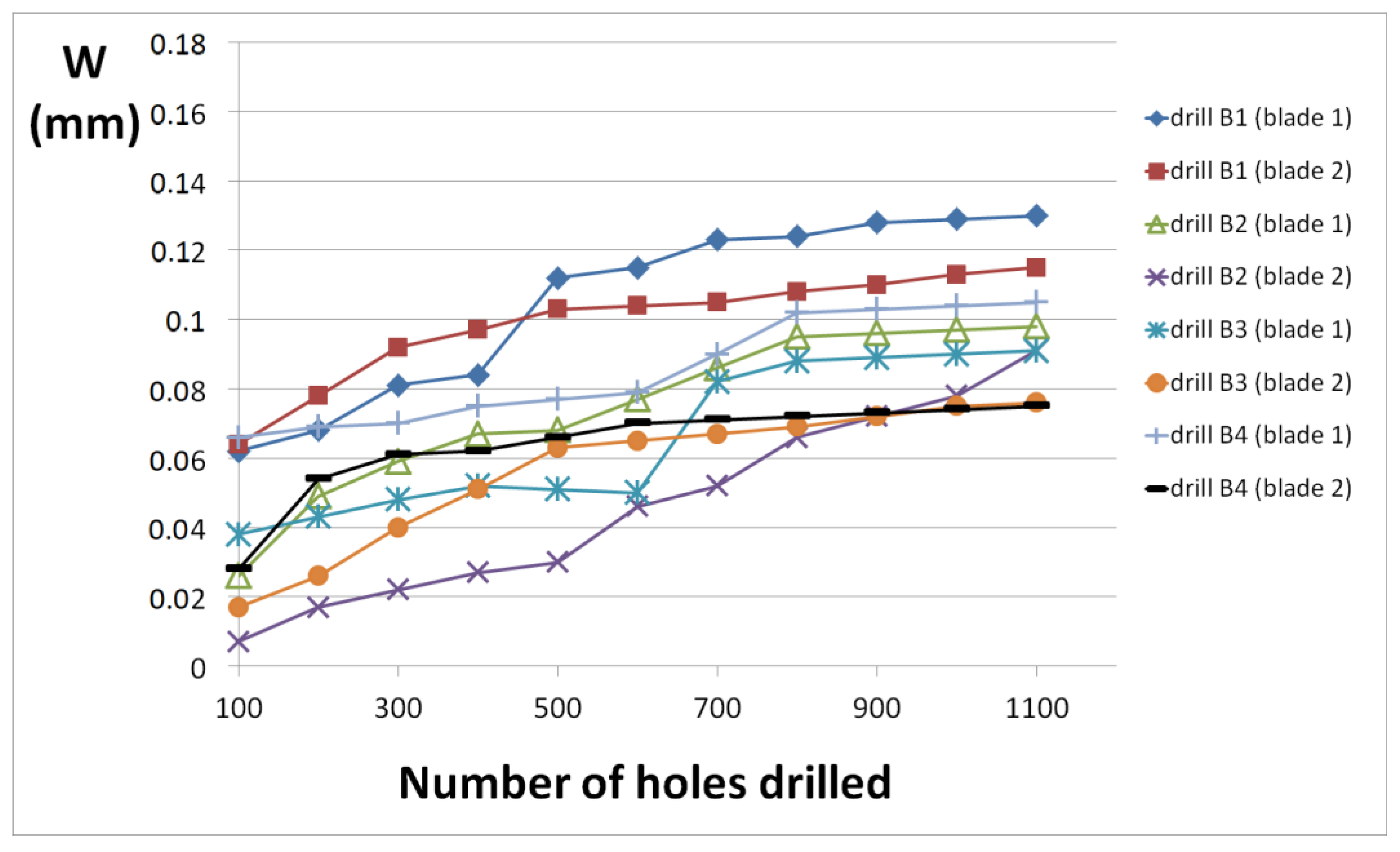

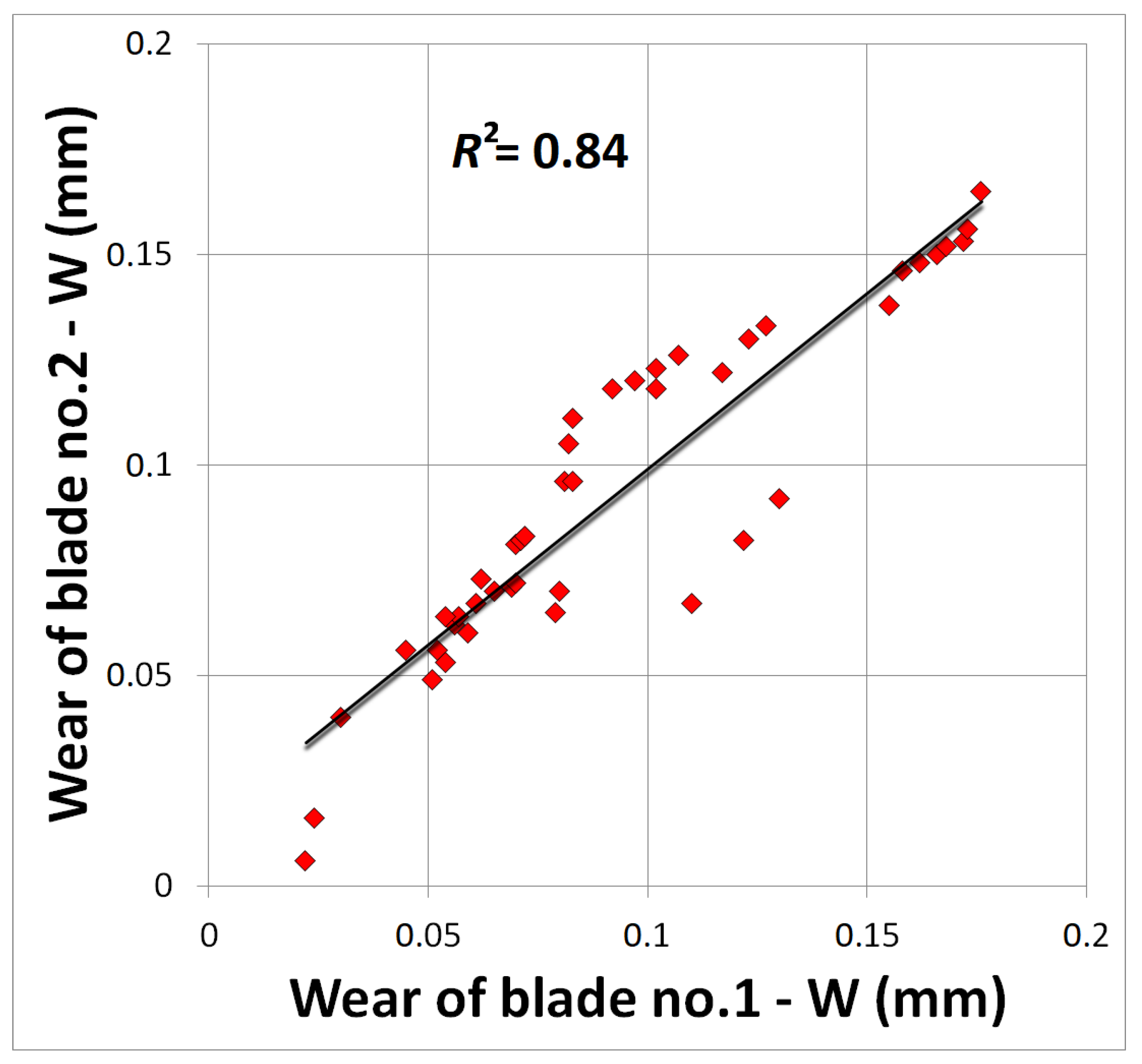
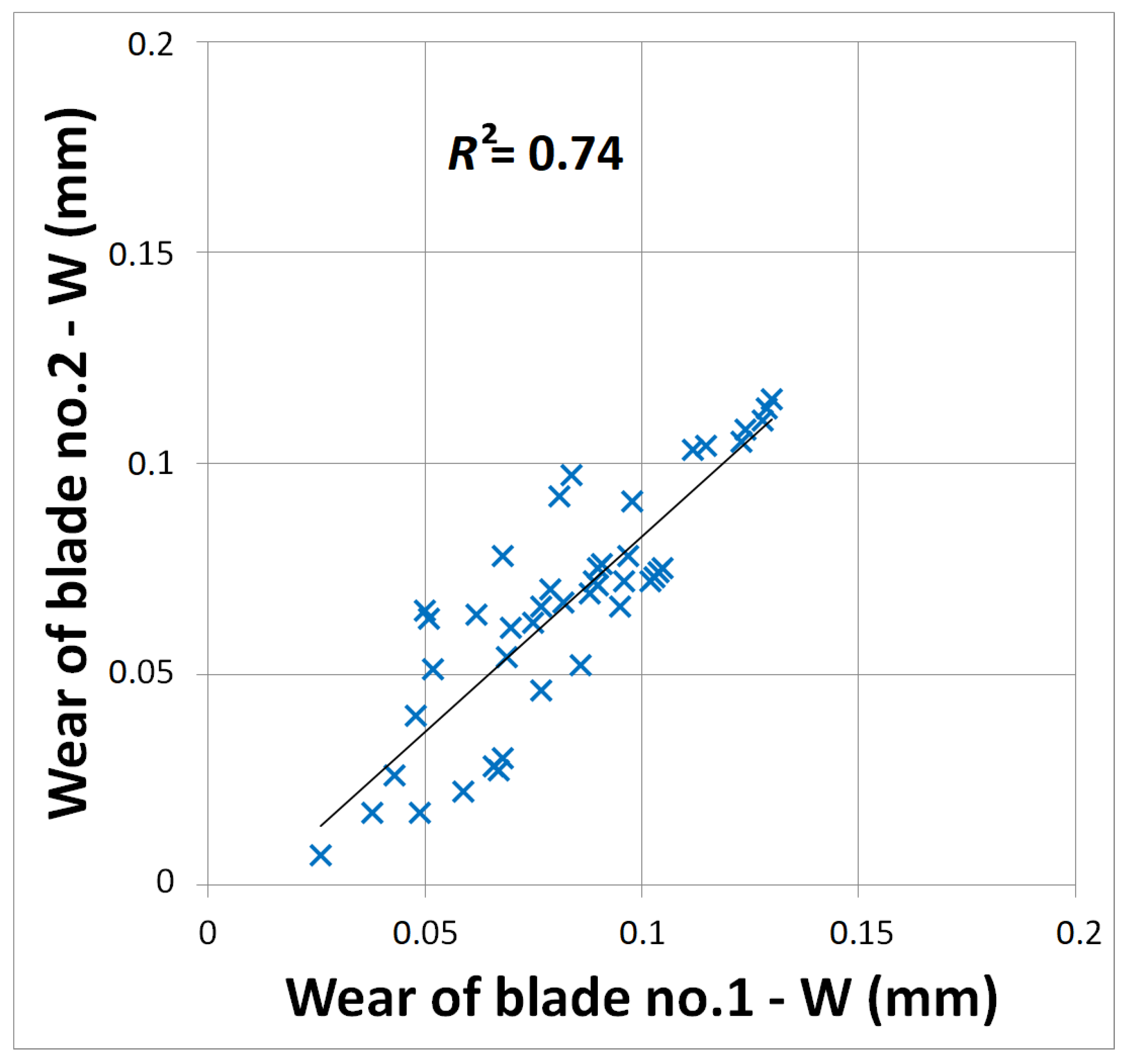
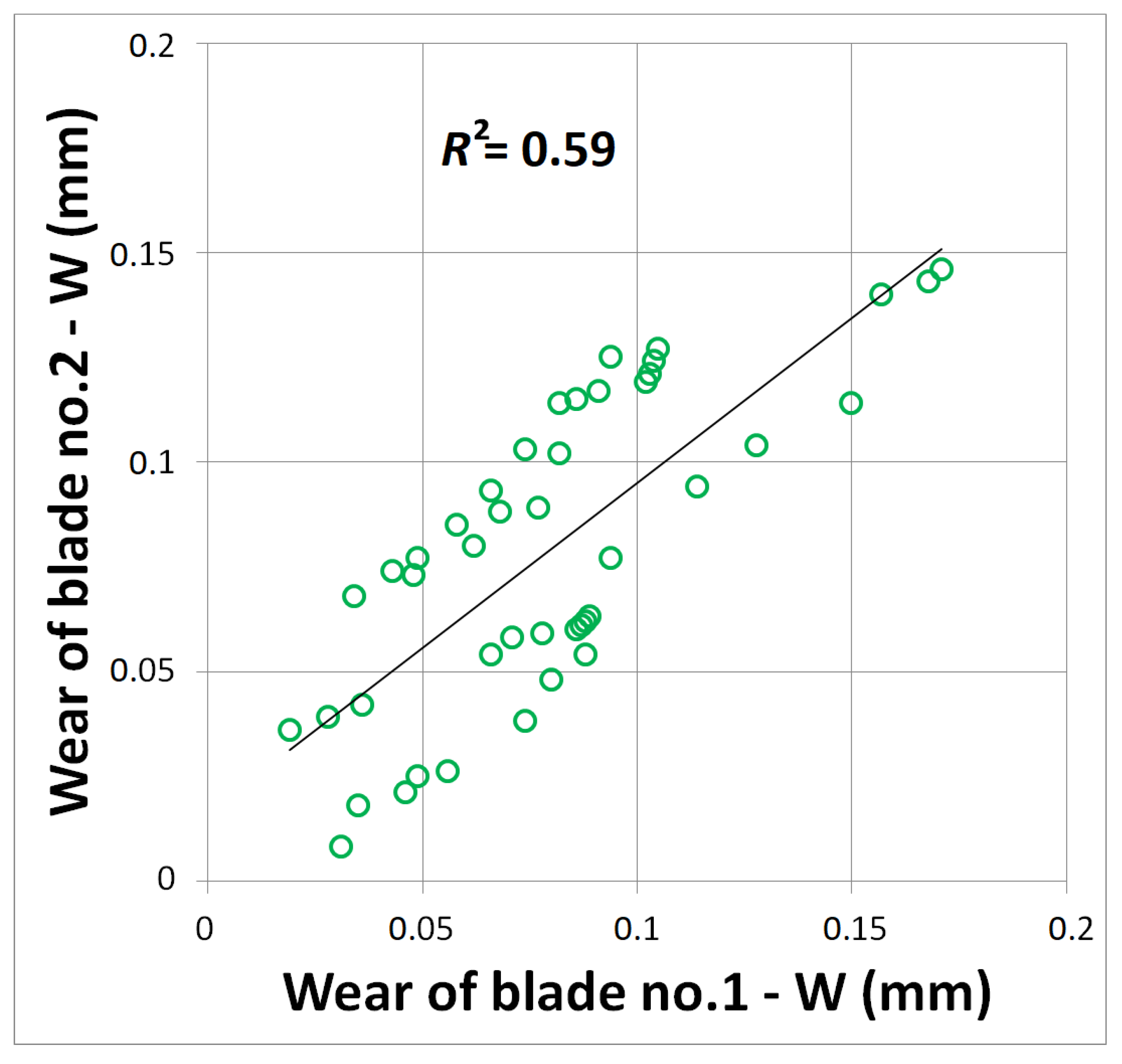
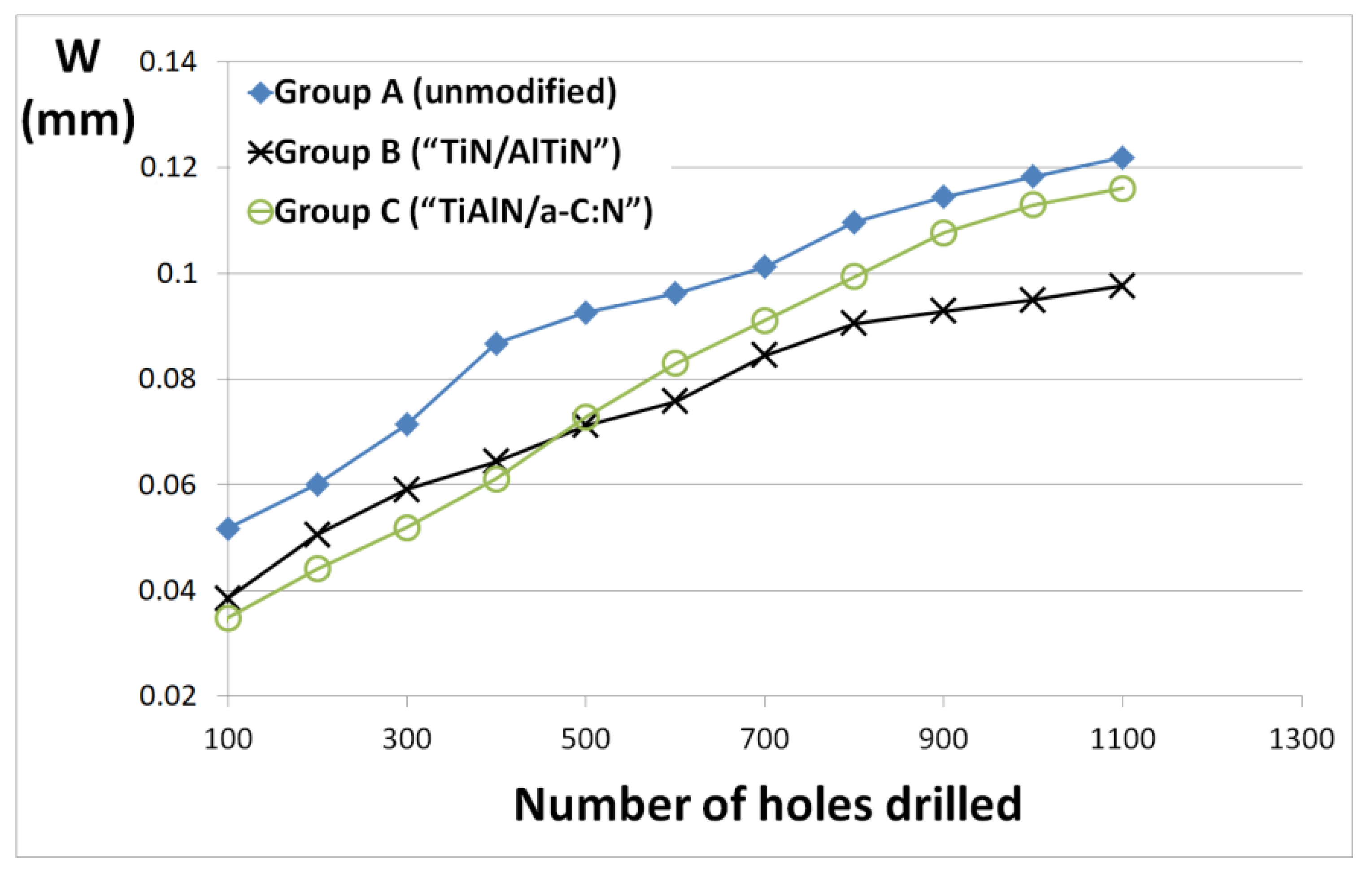

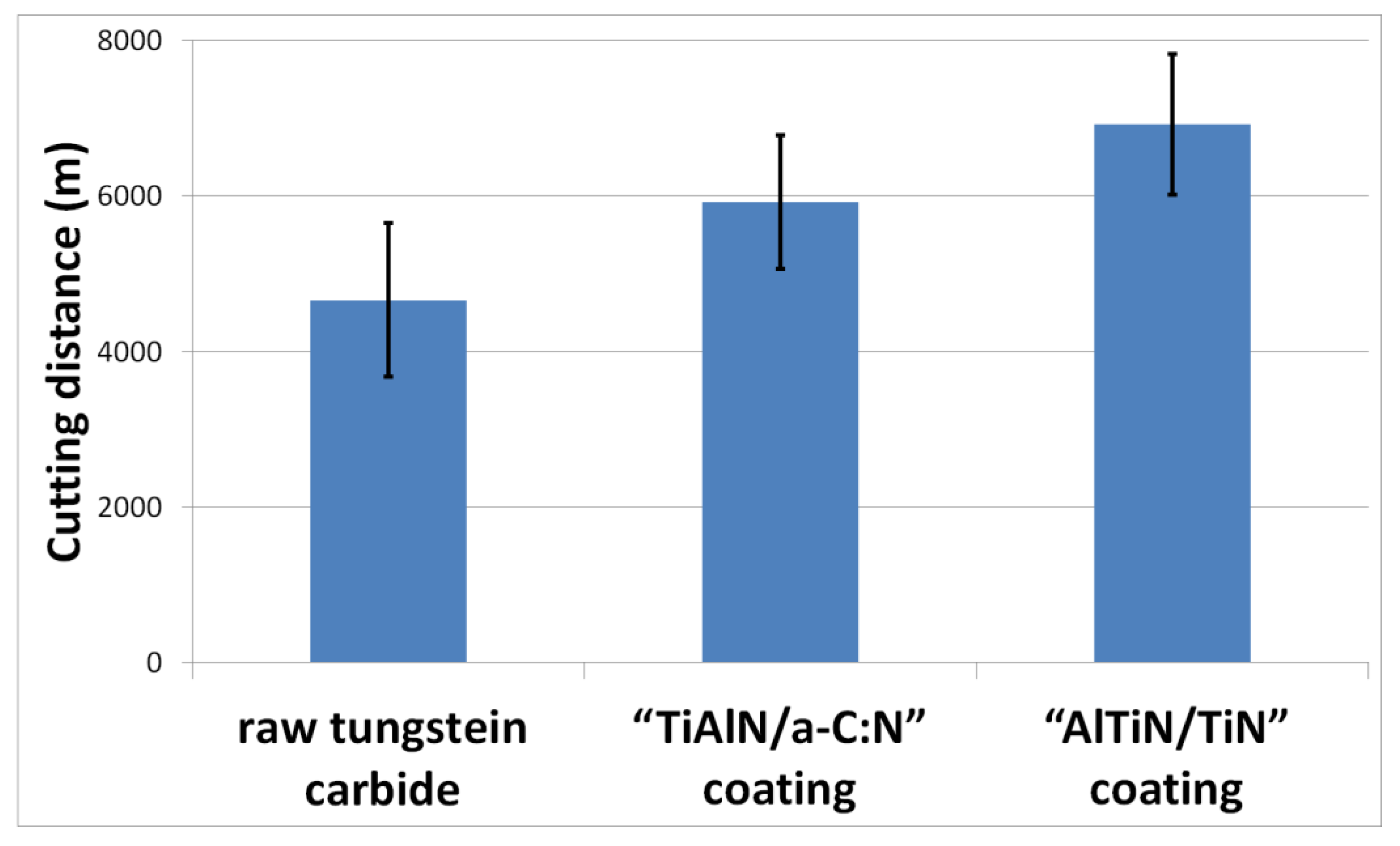
| Property Name | Physical Unit | Value |
|---|---|---|
| Density | (kg/m3) | 650 |
| Flexural strength | (N/mm2) | 13.1 |
| Elastic modulus | (N/mm2) | 3200 |
| Tensile strength | (N/mm2) | 0.37 |
| Strength in pull out of screws test | (N/mm) | 70.9 |
| Hardness in Brinnel scale | (HB) | 2.61 |
| Mineral contamination | (%) | 0.18 |
| Swelling 24 h | (%) | 25.6 |
| No. of Hole | Progress of Drill Blades Wear—W (mm) No. of Drill/No. of Blade | |||||||
|---|---|---|---|---|---|---|---|---|
| A1/1 | A1/2 | A2/1 | A2/2 | A3/1 | A3/2 | A4/1 | A4/2 | |
| 100 | 0.11 | 0.067 | 0.052 | 0.056 | 0.022 | 0.006 | 0.045 | 0.056 |
| 200 | 0.12 | 0.082 | 0.059 | 0.06 | 0.024 | 0.016 | 0.054 | 0.064 |
| 300 | 0.13 | 0.092 | 0.079 | 0.065 | 0.03 | 0.04 | 0.062 | 0.073 |
| 400 | 0.155 | 0.138 | 0.08 | 0.07 | 0.051 | 0.049 | 0.07 | 0.081 |
| 500 | 0.158 | 0.146 | 0.081 | 0.096 | 0.054 | 0.053 | 0.071 | 0.082 |
| 600 | 0.162 | 0.148 | 0.082 | 0.105 | 0.056 | 0.062 | 0.072 | 0.083 |
| 700 | 0.166 | 0.15 | 0.083 | 0.111 | 0.057 | 0.064 | 0.083 | 0.096 |
| 800 | 0.168 | 0.152 | 0.102 | 0.118 | 0.061 | 0.067 | 0.092 | 0.118 |
| 900 | 0.172 | 0.153 | 0.117 | 0.122 | 0.065 | 0.07 | 0.097 | 0.12 |
| 1000 | 0.173 | 0.156 | 0.123 | 0.13 | 0.069 | 0.071 | 0.102 | 0.123 |
| 1100 | 0.176 | 0.165 | 0.127 | 0.133 | 0.07 | 0.072 | 0.107 | 0.126 |
| No. of Hole | Progress of Drill Blades Wear—W (mm) No. of Drill/No. of Blade | |||||||
|---|---|---|---|---|---|---|---|---|
| B1/1 | B1/2 | B2/1 | B2/2 | B3/1 | B3/2 | B4/1 | B4/2 | |
| 100 | 0.062 | 0.064 | 0.026 | 0.007 | 0.038 | 0.017 | 0.066 | 0.028 |
| 200 | 0.068 | 0.078 | 0.049 | 0.017 | 0.043 | 0.026 | 0.069 | 0.054 |
| 300 | 0.081 | 0.092 | 0.059 | 0.022 | 0.048 | 0.04 | 0.07 | 0.061 |
| 400 | 0.084 | 0.097 | 0.067 | 0.027 | 0.052 | 0.051 | 0.075 | 0.062 |
| 500 | 0.112 | 0.103 | 0.068 | 0.03 | 0.051 | 0.063 | 0.077 | 0.066 |
| 600 | 0.115 | 0.104 | 0.077 | 0.046 | 0.05 | 0.065 | 0.079 | 0.07 |
| 700 | 0.123 | 0.105 | 0.086 | 0.052 | 0.082 | 0.067 | 0.09 | 0.071 |
| 800 | 0.124 | 0.108 | 0.095 | 0.066 | 0.088 | 0.069 | 0.102 | 0.072 |
| 900 | 0.128 | 0.11 | 0.096 | 0.072 | 0.089 | 0.072 | 0.103 | 0.073 |
| 1000 | 0.129 | 0.113 | 0.097 | 0.078 | 0.09 | 0.075 | 0.104 | 0.074 |
| 1100 | 0.13 | 0.115 | 0.098 | 0.091 | 0.091 | 0.076 | 0.105 | 0.075 |
| No. of Hole | Progress of Drill Blades Wear—W (mm) No. of Drill/No. of Blade | |||||||
|---|---|---|---|---|---|---|---|---|
| C1/1 | C1/2 | C2/1 | C2/2 | C3/1 | C3/2 | C4/1 | C4/2 | |
| 100 | 0.056 | 0.026 | 0.031 | 0.008 | 0.019 | 0.036 | 0.034 | 0.068 |
| 200 | 0.074 | 0.038 | 0.035 | 0.018 | 0.028 | 0.039 | 0.048 | 0.073 |
| 300 | 0.08 | 0.048 | 0.046 | 0.021 | 0.036 | 0.042 | 0.062 | 0.08 |
| 400 | 0.088 | 0.054 | 0.049 | 0.025 | 0.043 | 0.074 | 0.068 | 0.088 |
| 500 | 0.094 | 0.077 | 0.066 | 0.054 | 0.049 | 0.077 | 0.077 | 0.089 |
| 600 | 0.114 | 0.094 | 0.071 | 0.058 | 0.058 | 0.085 | 0.082 | 0.102 |
| 700 | 0.128 | 0.104 | 0.078 | 0.059 | 0.066 | 0.093 | 0.086 | 0.115 |
| 800 | 0.15 | 0.114 | 0.086 | 0.06 | 0.074 | 0.103 | 0.091 | 0.117 |
| 900 | 0.157 | 0.14 | 0.087 | 0.061 | 0.082 | 0.114 | 0.102 | 0.119 |
| 1000 | 0.168 | 0.143 | 0.088 | 0.062 | 0.094 | 0.125 | 0.103 | 0.121 |
| 1100 | 0.171 | 0.146 | 0.089 | 0.063 | 0.105 | 0.127 | 0.104 | 0.124 |
Publisher’s Note: MDPI stays neutral with regard to jurisdictional claims in published maps and institutional affiliations. |
© 2022 by the authors. Licensee MDPI, Basel, Switzerland. This article is an open access article distributed under the terms and conditions of the Creative Commons Attribution (CC BY) license (https://creativecommons.org/licenses/by/4.0/).
Share and Cite
Czarniak, P.; Szymanowski, K.; Panjan, P.; Górski, J. Initial Study of the Effect of Some PVD Coatings (“TiN/AlTiN” and “TiAlN/a-C:N”) on the Wear Resistance of Wood Drilling Tools. Forests 2022, 13, 286. https://doi.org/10.3390/f13020286
Czarniak P, Szymanowski K, Panjan P, Górski J. Initial Study of the Effect of Some PVD Coatings (“TiN/AlTiN” and “TiAlN/a-C:N”) on the Wear Resistance of Wood Drilling Tools. Forests. 2022; 13(2):286. https://doi.org/10.3390/f13020286
Chicago/Turabian StyleCzarniak, Paweł, Karol Szymanowski, Peter Panjan, and Jarosław Górski. 2022. "Initial Study of the Effect of Some PVD Coatings (“TiN/AlTiN” and “TiAlN/a-C:N”) on the Wear Resistance of Wood Drilling Tools" Forests 13, no. 2: 286. https://doi.org/10.3390/f13020286
APA StyleCzarniak, P., Szymanowski, K., Panjan, P., & Górski, J. (2022). Initial Study of the Effect of Some PVD Coatings (“TiN/AlTiN” and “TiAlN/a-C:N”) on the Wear Resistance of Wood Drilling Tools. Forests, 13(2), 286. https://doi.org/10.3390/f13020286








